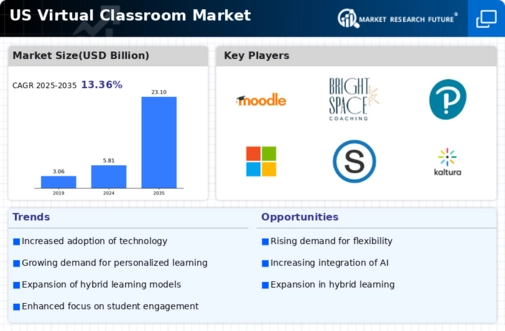The US Virtual Classroom Market has evolved significantly, driven by advancements in technology and increasing demand for flexible learning solutions. The competitive landscape is shaped by a multitude of factors including the integration of artificial intelligence, mobile accessibility, and personalization of learning experiences. Market participants are focused on enhancing user engagement and facilitating collaborative learning, which has become essential in the current education environment. Companies are investing in robust platforms that not only cater to educational institutions but also include corporate training and skill development arenas.
As the emphasis on remote learning persists, understanding the competitive dynamics among key players is critical for stakeholders aiming to optimize their market strategies and improve educational outcomes through virtual classrooms. Moodle has established a strong presence in the US Virtual Classroom Market, recognized for its open-source learning management system which offers extensive customization options. One of the significant strengths of Moodle is its flexibility, allowing institutions to tailor their online teaching and learning environments according to specific needs. The platform is well-regarded for fostering community-driven development, which continuously adds valuable features and enhancements based on user feedback.
Additionally, Moodle offers a wide array of functionalities such as course management, assessment tools, and collaboration features that cater to both educational and organizational settings. With an active user community and a commitment to open education, Moodle positions itself as a leading player while advocating for equitable access to education across various demographics. Brightspace, a prominent name in the US Virtual Classroom Market, is recognized for its cloud-based learning platform that simplifies the complexities of managing online education.
Its key products and services focus on personalized learning experiences that cater to diverse learner needs, making it a preferred choice for many educational institutions. Brightspace provides comprehensive analytics and reporting capabilities that allow educators to track student progress and tailor instruction accordingly. A strength of Brightspace lies in its commitment to continuous innovation, ensuring that it remains competitive through regular updates and feature introductions. The company has actively pursued strategic mergers and acquisitions to enhance its technological capabilities and expand its market footprint, which further solidifies its position in the US market.
By enabling rich multimedia content and fostering engaging learning experiences, Brightspace continues to be a vital player in shaping the future of virtual classrooms in the region.





















